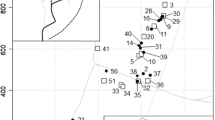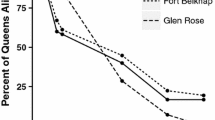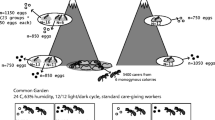Abstract
In two nearctic ants, Leptothorax canadensis and Leptothorax sp. A, young queens may either found their own nest solitarily after mating or seek adoption into an established colony. Whether a queen disperses or not is associated with genetically determined queen morphology in Leptothorax sp. A. Whereas a majority of winged queens attempt solitary colony founding after mating, most wingless, intermorphic queens return to their maternal nests and new colonies are founded by budding after hibernation. The latter strategy appears to be correlated with patchy, isolated habitats, whereas in extended boreal forests dispersal on the wing is probably more common. Alternative dispersal strategies strongly affect the average number of queens per colony and seasonal fluctuations of colony structure.
Similar content being viewed by others
References
Alloway TM, Buschinger A, Talbot M, Stuart R, Thomas C (1982) Polygyny and polydomy in three North American species of the ant genus Leptothorax Mayr (Hymenoptera: Formicidae). Psyche 89:249–274
Aukema B (1991) Fecundity in relation to wing-morph of three closely related species of the melanocephalus group of the genus Calathus (Coleoptera: Carabidae). Oecologia 87:118–126
Bolton B (1986) Apterous females and shift of dispersal strategy in the Monomorium salomonis-group (Hymenoptera: Formicidae). J Nat Hist 20:267–272
Briese DT (1983) Different modes of reproductive behaviour (including a description of colony fission) in a species of Chelaner (Hymenoptera: Formicidae). Insectes Soc 30:308–316
Buschinger A (1974) Experimente und Beobachtungen zur Gründung und Entwicklung neuer Sozietäten der sklavenhaltenden Ameise Harpagoxenus sublaevis (Nyl.). Insectes Soc 21:381–406
Buschinger A (1978) Genetisch bedingte Entstehung geflügelter Weibchen bei der sklavenhaltenden Ameise Harpagoxenus sublaevis (Nyl.) (Hym., Form.). Insectes Soc 25:163–172
Buschinger A, Alloway TM (1978) Caste polymorphism in Harpagoxenus canadensis M.R. Smith (Hym., Formicidae). Insectes Soc 25: 339–350
Buschinger A, Heinze J (1992) Polymorphism of female reproductives in ants. In: Billen J (ed) Biology and evolution of social insects. Leuven University Press, Leuven, pp 11–23
Buschinger A, Winter U (1976) Funktionelle Monogynie bei der Gastameise Formicoxenus nitidulus (Nyl.) (Hym., Form.). Insectes Soc 23:549–558
Den Boer PJ (1990) Density limits and survival of local populations in 64 carabid species with different powers of dispersal. J Evol Biol 3:19–48
Eidmann H (1933) Zur Kenntnis der Ameisenfauna von Südlabrador. Zool Anz 101:201–221
Francoeur A (1986) Deux nouvelles fourmis néarctiques: Leptothorax retractus et L. sphagnicolus (Formicidae, Hymenoptera). Can Entomol 118:1151–1164
Francoeur A, Loiselle R, Buschinger A (1985) Biosystématique de la tribu Leptothoracini (Formicidae, Hymenoptera). 1. Le genre Formicoxenus dans la région holarctique. Nat Can 112:343–403
Harrison RG (1980) Dispersal polymorphism in insects. Annu Rev Ecol Syst 11:95–118
Heinze J (1989a) Alternative dispersal strategies in a North American ant. Naturwissenschaften 76:477–478
Heinze J (1989b) A biochemical approach toward the systematics of the Leptothorax “muscorum” group in North America (Hymenoptera: Formicidae). Biochem Syst Ecol 17:595–601
Heinze J, Buschinger A (1987) Queen polymorphism in a nonparasitic Leptothorax species (Hymenoptera, Formicidae). Insectes Soc 34:28–43
Heinze J, Buschinger A (1988a) Polygyny and functional monogyny in Leptothorax ants (Hymenoptera: Formicidae). Psyche 95:309–325
Heinze J, Buschinger A (1988b) Electrophoretic variability of esterases in the ant-tribe Leptothoracini. Biochem Syst Ecol 16:217–221
Heinze J, Buschinger A (1989) Queen-polymorphism in Leptothorax spec. A: its genetic and ecological background (Hymenoptera: Formicidae). Insectes Soc 36:139–155
Heinze J, Smith TA (1990) Dominance and fertility in a functionally monogynous ant. Behav Ecol Sociobiol 27:1–10
Heinze J, Hölldobler B, Cover SP (1992a) Queen polymorphism in the North American harvester ant, Ephebomyrmex imberbiculus. Insectes Soc 39:267–273
Heinze J, Lipski N, Hölldobler B (1992b) Reproductive competition in colonies of the ant Leptothorax gredleri. Ethology 90: 265–278
Herbers JM (1986a) Ecological genetics of queen number in Leptothorax longispinosus (Hymenoptera: Formicidae). Entomol Gen 111:119–123
Herbers JM (1986b) Nest site limitation and facultative polygyny in the ant Leptothorax longispinosus. Behav Ecol Sociobiol 19:115–122
Herbers JM (1989) Community structure in north temperate ants: temporal and spatial variation. Oecologia 81:201–211
Hölldobler B, Bartz SH (1985) Sociobiology of reproduction in ants. In: Hölldobler B, Lindauer M (eds) Experimental behavioral ecology and sociobiology. Sinauer, Sunderland, pp 237–257
Hölldobler B, Carlin NF (1985) Colony founding, queen dominance and oligogyny in the Australian meat ant Iridomyrmex purpureus. Behav Ecol Sociobiol 18:45–58
Hölldobler B, Wilson EO (1977) The number of queens: an important trait in ant evolution. Naturwissenschaften 64:8–15
Hölldobler B, Wilson EO (1990) The ants. Harvard University Press, Cambridge
Keller L (1991) Queen number, mode of colony founding, and queen reproductive success in ants (Hymenoptera Formicidae). Ethol Ecol Evol 3:307–316
Keller L, Ross KG (1993) Phenotypic basis of reproductive success in a social insect: genetic and social determinants. Science 260:1107–1110
Loiselle R, Francoeur A (1988) Régression du dimorphisme sexuel dans le genre Formicoxenus et polymorphisme comparé des sexes dans la famille des Formicidae (Hymenoptera). Nat Can 115:367–378
Loiselle R, Francoeur A, Fischer K, Buschinger A (1990) Variations and taxonomic significance of the chromosome numbers in the nearctic species of the genus Leptothorax (s.s.) (Formicidae: Hymenoptera). Caryologia 43:321–334
Peeters C (1991) Ergatoid queens and intercastes in ants: two distinct adult forms which look morphologically intermediate between workers and winged queens. Insectes Soc 38:1–15
Punttila P, Haila Y, Pajunen T, Tukia H (1991) Colonisation of clearcut forests by ants in the southern Finnish taiga: a quantitative survey. Oikos 61:250–262
Roff DA (1980) The evolution of wing dimorphism in insects. Evolution 40:1009–1020
Roff DA, Fairbairn DJ (1991) Wing dimorphism and the evolution of migratory polymorphisms among the insecta. Am Zool 31:243–251
Rosengren R, Pamilo P (1983) The evolution of polygyny and polydomy in mound-building Formica ants. Acta Entomol Fenn 42:65–77
Ross KG (1992) Strong selection on a gene that influences reproductive competition in a social insect. Nature 355:347–349
Sachs L (1992) Angewandte Statistik, 7th edn. Springer, Berlin
Sokal RR, Rohlf FJ (1981) Biometry, 2nd edn. Freeman, New York
Sundström L (1990) Monogyny or polygyny — a result of different dispersal tactics in red wood ants (Formica; Hymenoptera). In: Veeresh GK, Mallik CA, Viraktamath CA (eds) Social insects and the environment. Oxford & IBH, New Delhi, pp 245–246
Tinaut A, Heinze J (1992) Wing reduction in ant queens from arid habitats. Naturwissenschaften 79:84–85
Varvio-Aho S-L, Järvinen O, Vepsäläinen K (1978) Enzyme gene variation in three species of water-striders (Gerris) (Heteroptera, Gerridae). Ann Entomol Fenn 44:87–94
Villet MH (1989) A syndrome leading to ergatoid queens in ponerine ants (Hymenoptera: Formicidae). J Nat Hist 23:825–832
Villet MH (1991) Colony foundation in Plectroctena mandibularis F. Smith, and the evolution of ergatoid queens in Plectroctena (Hymenoptera: Formicidae). J Nat Hist 25:979–983
Wagner DL, Liebherr JK (1992) Flightlessness in insects. Trends Ecol Evol 7:216–220
Zera AJ, Rankin MA (1989) Wing dimorphism in Gryllus rubens: genetic basis of morph determination and fertility differences between morphs. Oecologia 80:249–255
Author information
Authors and Affiliations
Rights and permissions
About this article
Cite this article
Heinze, J. Habitat structure, dispersal strategies and queen number in two boreal Leptothorax ants. Oecologia 96, 32–39 (1993). https://doi.org/10.1007/BF00318027
Received:
Accepted:
Issue Date:
DOI: https://doi.org/10.1007/BF00318027




